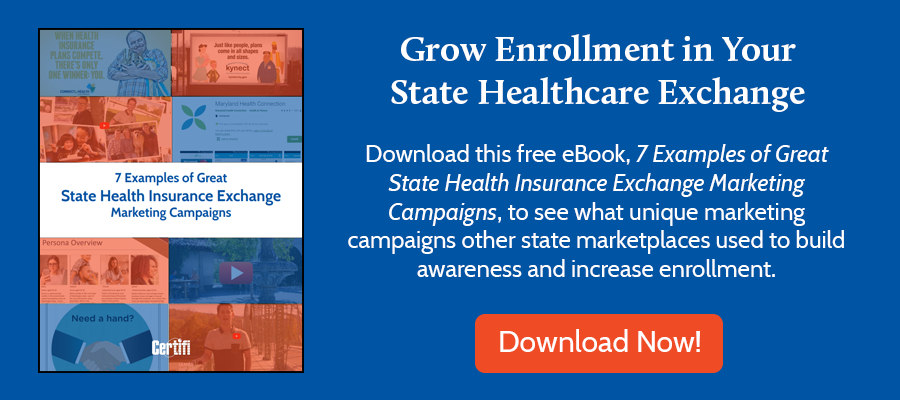In the past several years, numerous states have decided to transition to a state-based health insurance marketplace. Here’s a look at why to transition and steps to take when transitioning to a state-based exchange.
Why Transitioning to a State-based Exchange Makes Sense
There are numerous benefits to transitioning from the federal exchange to a state-based exchange. Chief among them:
- Cost savings — Because the federal program charges states to access the federal enrollment platform, many states that have recently transitioned or are planning to transition to a state-based exchange have used cost-savings as the primary motivation for the transition. For example, Nevada estimated they would save $6 million a year. The cost savings alone can be a compelling argument for a state to transition to a state-based exchange.
- Reinvestments can drive down premiums, increase enrollment. For Pennsylvania, one of the primary reasons to transition to a state-based exchange was to build a reinsurance program that would drive down premiums. In turn, that would lead to increased enrollment and increased carrier participation. Pennsylvania estimated that they could lower premiums by as much as 5% by transitioning to a state-based exchange and leveraging those savings to build a reinsurance program.
- Ability to tailor programs to state demographics/needs — Most states with state-based exchanges had Special Enrollment Periods (SEPs) during the coronavirus pandemic that allowed residents to enroll in a health plan without any kind of qualifying event. The federal exchange did not. It’s a prime example of how transitioning to a state-based exchange gives a state more flexibility to create an experience tailored to its residents.
- Better Data Access — If you have a federal exchange, not much data is shared with you. Even simple information like enrollment by plan can be difficult to get to make improvements to your health insurance marketplace. By becoming a state-based exchange, you’ll own all the data related to your exchange. That data will help you make more informed decisions for your marketplace.
Transition Steps
Get buy-in from Legislative stakeholders
The first step in your transition is to build consensus among governmental stakeholders. That could mean making a case to your legislature’s finance committee for funding, working with the governor’s office to move the political ball forward, and working with the Center for Medicare and Medicaid Services (CMS) to explain your transition plan.
To get buy-in, you’ll need to make the case of why a state-based exchange is best for your state. For Pennsylvania, which recently transitioned to a state-based exchange, focusing on cost savings and how they could turn those cost savings into a reinsurance program that lowered premiums was the obvious choice.
For other states, in addition to cost savings, having control of data, and building complete datasets on exchange members was a significant reason for the move.
Get buy-in from other stakeholders (carriers, brokers, etc.)
Running a successful state-based health insurance exchange relies on other stakeholders as well. You’ll need carriers and brokers to work with you to ensure the success of your exchange. As you build your exchange platform, you’ll need to ensure you don’t overlook existing federal healthcare.gov features. So keep an open dialogue with potential carriers and brokers to get their feedback on the new state platform.
It’s also a good practice to consider what features you want in your state exchange platform, as well. Traditionally, that includes enrollment and eligibility, plan comparison, and integrations to other data sources for things like income verification. But it’s also important to consider consolidated billing in your state health insurance exchange — something New Mexico is building to simplify the billing process and improve the member experience. Then build a roadmap for future features and functions. Maryland, for example, built an app that makes enrolling and submitting documentation easy from a mobile device.
Select Vendors
Once you’ve gotten buy-in from stakeholders, the next step in transitioning to a state-based exchange is vendor selection. Several states created a Request for Information (RFI) the year before they created a Request for Proposals (RFP). That gave them a base of knowledge that they could leverage when creating their RFP. If your timeline allows, that’s a good practice.
For most states, the vendor selection process fell into four categories:
- Technology — Generally, this is the enrollment and plan comparison platform the state will use. When states first rolled out their state exchanges, these were largely custom-built development efforts. Today, many states are turning to off-the-shelf solutions like GetInsured to quickly and cost-effectively stand up an exchange platform. That said, you’ll likely still need internal or external development resources to integrate data. An example would be integrating with your internal systems for data verification or integrating with the federal data services hub for things like income verification.
- Call Center — Some states have outsourced their call centers. If you decide to outsource, you’ll want to find a partner that can manage your call center. Some states will choose a technology partner that can provide both the technology and call center services, while other states choose a distinct technology partner and a distinct call center partner.
- Security — Because you’re handling sensitive personal information, security is also key to operating your exchange. You’ll likely need multiple security certifications and audits to run your exchange. Most exchanges work with a security partner to implement and test system security.
- Marketing/Communications — Experience has taught many exchanges that maximizing enrollment in a state exchange requires significant marketing outlays. Creating and executing a marketing strategy that targets specific populations and leverages relevant marketing tactics requires marketing expertise. For most state exchanges, that means engaging a marketing consultant or agency.
Migrate Data
Because you’re moving from the federal marketplace to a state-based marketplace, you’ll need to migrate data to provide a seamless transition for members. For most states, that starts with mapping the data. Then, retrieve test data from the federal exchange to run a test of the migration. Because you’ll want that data to be as recent as possible — yet want enough time to correct any data errors – most states get a full data dump a month or two in advance of their first open enrollment then get change files from the federal exchange periodically until they’re live. Whatever your plan, make sure you’ve built enough time to thoroughly test the data migration and ensure a great user experience.
Create a Marketing Plan
It’s important to start marketing at least a year before transitioning to a state-based exchange. Why? Because studies continue to show — even in mature exchanges — that state residents are unaware of the exchange and/or available subsidies. So you must create a marketing plan with at least two prongs:
- To build brand awareness
- To market the open enrollment period to specific target audiences
When Colorado rolled out their state exchange, Connect for Health Colorado, they created a brand launch campaign that ran from July to September. The state’s research found that Coloradans had very low awareness or understanding of their exchange. To build awareness, they created a campaign with a core message of “When health insurance companies compete, there’s only one winner: You!”

Closer to open enrollment, you can create a marketing plan that engages enrollees. The Washington Health Benefit Exchange leveraged personas to help them better understand their core audiences and then tailored messages to those personas based on where they were in the enrollment process. This targeting and personalization helped them exceed their enrollment goal by 2,000.
Click here for more examples of great state health insurance exchange marketing campaigns.
Maintain Enrollment
Once you’ve completed the first open enrollment period on the state exchange, your mentality should shift from rollout to active operation. For many state exchanges, that means shifting priorities to maintain enrollment. In many cases, that means providing a great member experience and member marketing.
Member marketing is different that open enrollment marketing. The key to great member marketing is member data. Personalization is the key to success. Understanding who your members are, which plans they’re enrolled in, the status of those plans and competing plans, and aggregate information about enrollment as a whole can help you create a member marketing plan personalized for like members or even each member.
Don’t forget a communications plan for brokers and assisters as well. Give them tools they can use to encourage existing and new customers to re-enroll in a health plan.
It’s also important to consistently use the past enrollment period as a guide to improving the next enrollment period. If there were any software issues, get those prioritized and fixed before the enrollment period. Any improvements — like a phone app — should also be prioritized, developed, and released before open enrollment. That leaves enough time to promote and encourage downloads before open enrollment.
Also review your key call center KPIs to understand wait times, resolution rates, and other key metrics and create a plan to improve those metrics. It’s also important to categorize incoming calls and identify common questions so you can create a knowledgebase for both internal and external consumption based on the most frequently asked questions.
Ongoing Innovation
Once you’ve had a couple of open enrollment periods under your belt, it’s time to think about additional ways to innovate. For example, Maryland has been working to automate as much of their process as they can. That includes leveraging AI to streamline and automate verification processes. Or, it could mean implementing a reinsurance program. You could implement a mobile app or develop tighter integrations with your state’s Medicaid division so you can make Medicaid assessments during enrollment. Whatever you do, always keep improving your exchange by measuring, strategizing, and then tactically deploying solutions that improve the exchange operationally and from a customer experience perspective.
Certifi helps private and public health insurance exchanges improve enrollment and build a better member experience with health insurance exchange consolidated billing and payment solutions.



